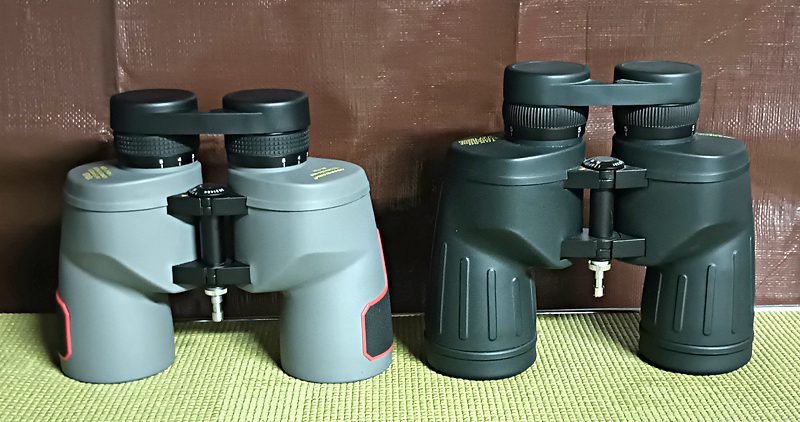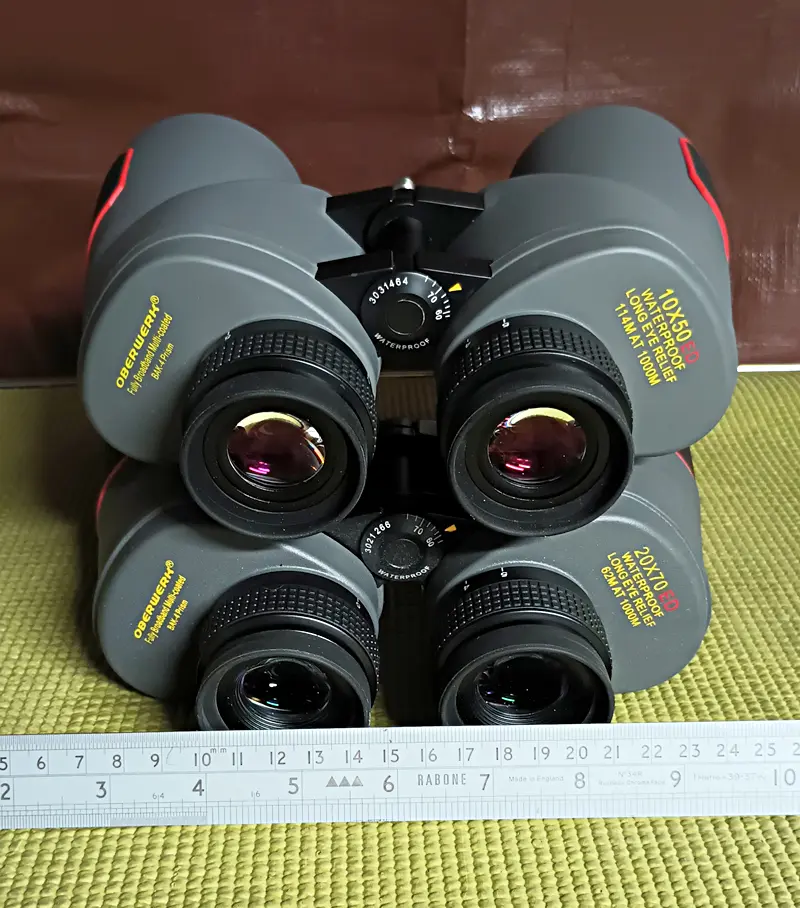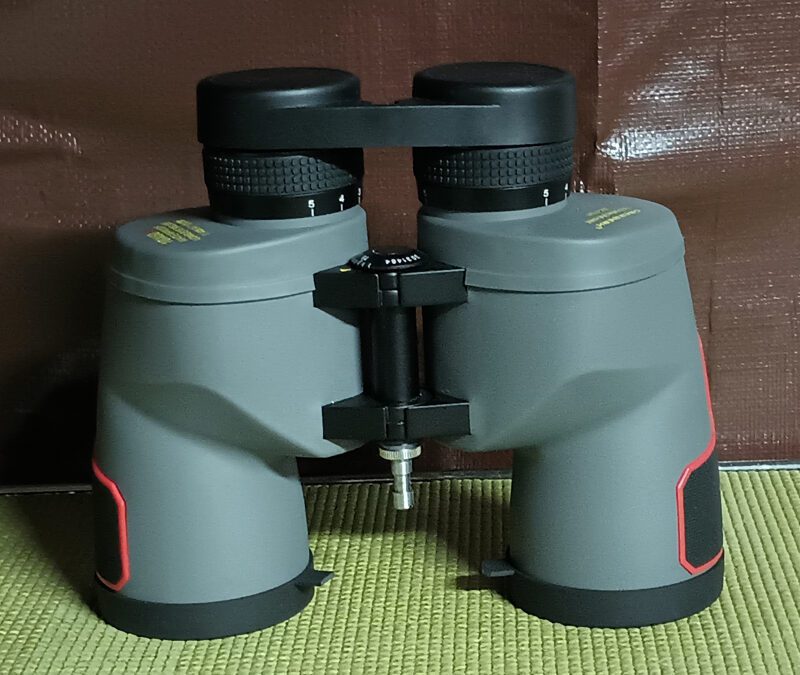My rebirth in binocular astronomy after decades of mostly telescopic observing began with an Oberwerk binocular — the 10×50 Ultra. A classic independent-focus porro prism binocular optimized for astronomy. I was immediately captivated by the binocular, which is ideally matched to my eye relief (eyecups folded down wearing glasses) and presents brilliant, immersive views that are remarkably sharp on-axis, rivaling the best 10x binoculars in production.
The successor to the 10×50 Ultra, the 10×50 Ultra ED, arrived at my doorstep in June. This is a pre-production sample, but it will soon be in stock at Oberwerk and listed on the website.
So, how does it match up with my much-beloved 10×50 Ultra?

As fond as I am of the original 10×50 Ultra, which will always have a place in my heart (and my binocular collection), I have to say that the the 10×50 ED Ultra is a step up.
Like its predecessor, the 10×50 ED Ultra has independent focus eyepieces, which are ideal for astronomy because they facilitate precise focusing. The EDU object covers are not captive (attached directly to the body of the instrument) having tethers attached to a center-hinge adapter, which I promptly replaced with a tripod adapter, unceremoniously trimming off that objective cover tethers to form short tabs.
It’s lighter than the original Ultra (47.5 ounces versus 54.9 ounces), and while 7.4 ounces doesn’t seem like much of a difference, the 10×50 EDU has a much lighter feel and is easier to hand hold.
It also has better eye-relief, with upgraded eyecups that have a short form factor made with soft, more pliable rubber so they fold and unfold easily. Wearing glasses, with the eyecups unfolded, I can easily see the entire field all the way to the crisp field rings. My eye relief requirements wearing glasses are less than the average, so the typical eyeglass wearer might not be able to see the entire field with the eyecups unfolded, but I had to fold the Ultra eyecups down to see the entire field. With the Ultra ED eyecups folded down, the typical eyeglass wearer might well be able to see the entire field.

The 10×50 EDU is shown above with another member of the Oberwerk Ultra family, the 20×70 EDU, which has nearly identical eyepieces. The eyecups are 45mm in diameter.
The edge performance of the original Ultra is less than ideal. Stars near the edge of the field are somewhat out of focus, which isn’t that noticeable in normal use, but the edge illumination is also lower and that is more noticeable. The EDU edge performance is better — sharp to about 85% of the field, and the edge illumination is much better so that stars near the edge of the field still seem bright and look natural in peripheral vision.
Comparing views of STF 2079 in the constellation Hercules between the Ultra and the Ultra ED, I would say if anything the ED is sharper on-axis than the Ultra, which is remarkable given how sharp the older model is. Either binocular compares favorably on-axis with the best 10x binoculars in production, which cost many times more.
STF 2079
16h39m +23°00′
7.56/8.13 sep 16.74″ pa 91.2°
Physical double star
Distance: 454.7 LY
Spectral Type: F0 / A5
Color Index: 0.38+ yellow-white / 0.36 yellow-white
These observations were made with the binoculars on a parallelogram mount. It is not possible to resolve this double with non-IS (Image Stabilized) 10x binoculars hand held. When observing handheld, sharpness is more of a general impression than something that can be precisely qualified by comparing detailed observations of close double star, lunar features, etc.
These are my initial impressions of the Oberwerk 10×50 Ultra ED, and they are quite favorable indeed. The 10×50 EDU will be a frequent observing companion in coming months, along with other binoculars, binocular telescopes, and support telescopes, blog post updates to follow. 😉


Fiske, already looking forward to your future reports on this 10×50 EDU once the longer, darker nights begin to set back in. Id like to hear how it compares to your Fujinon 10×50
Wrighty! I’m sorry I didn’t see your comment sooner. I plan to do comparisons between the 10×50 EDU and the Fujinon, so impressions to follow. Unfortunately, at present skies here are white from Canada forest fire smoke. Only a few of the brightest stars can be seen naked-eye at night. This has been the worst spring/summer (so far) for astronomy that I can remember. 😂
Great article about the new ED Ultra member!
I’m looking forward to future comparsion, especially how it compares to the other members of the ED Ultra line. I know the 10x50U was the standout in it’s series (mine is noticeably sharper than my 15x70U), so I’m wondering if it’ll be the standout in the EDU series also. It’ll have to be phenomenal to get much better than the 12x50EDU & 20x70EDU (I’m still trying to figure out which one of these preforms best…)
I still have been able to bring myself to cutting the original tethered caps on the 12x50EDU yet 🤣.
I’ve been tempted multiple times. I’d hoped they’d fit over the Farpoint Farsight adapter I use but the lugs slightly too big. Even then, I’d still have to take the tethers off in order to mount it so they’d still be in the way regardless.
So for now I’ve left them as-is, and just remove them to use a standard tripod adapter whenever using mounted. Hopefully Oberwerk will get some in-stock soon so I can modify a set.
BTW: Even though they’re not tethered to the barrels, I like the fit of the ED Ultra objective covers MUCH better than the original Ultra’s. Even the Deluxe has better fitting covers than the Ultra series…
Yes. Agreed about the fit. A big improvement. 👌
As much as I love the 10×50 Ultra, the ED Ultra is a step up. I don’t know if it will be my favorite of the entire ED Ultra line, I more or less expect to love all of them. That applies to all those currently in my collection — 10×50, 12×50, 15×56, 20×70, and 25×100. I had the 25×100 out last night on the PM2 p-gram, which is the ideal mount for that instrument, IMO. 😉